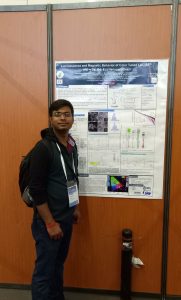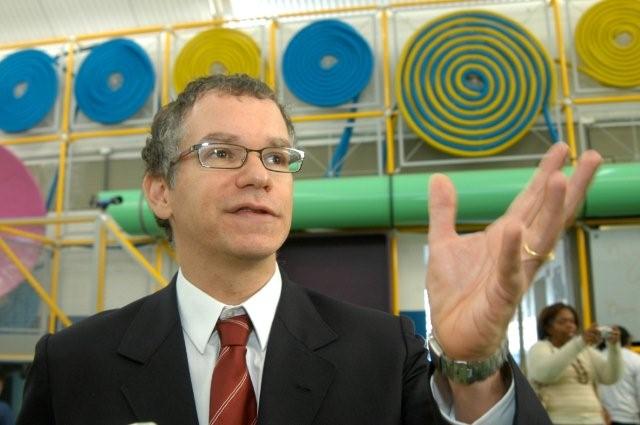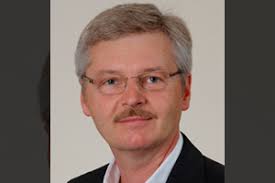
Christian Polak first interacted with Vacuumschmelze GmbH & Co when his PhD thesis on amorphous materials, defended in the Technical University of Vienna (TU Wien), aroused the company´s interest. In 1993, he began working in the research and development area of the company, where he remains.
Vacuumschmelze started its activities about 100 years ago with the development of the first vacuum melting furnace (as suggested by its name in German) in the city of Hanau (Germany). Today, the company is a manufacturer of advanced magnetic materials and related products with more than 4,000 employees located in dozens of countries. These materials are present in the daily lives of millions of people, being part of cars, airplanes, elevators, solar and wind energy systems, transformers and more.
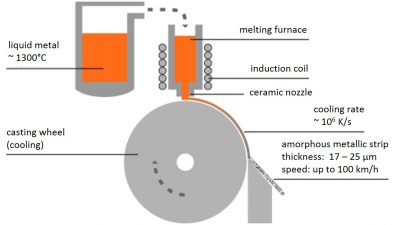
Currently, Dr Christian Polak heads the company’s Department for Rapid Solidification Technology. This process makes it possible to produce micrometric thick metal strips with superior magnetic properties by processing molten metal in only one step. Further processes can transform these amorphous materials into nanocrystalline alloys, whose grains are nanometric.
At the XVII B-MRS Meeting, Dr Polak will offer a plenary lecture on nanocrystalline magnetic materials and their applications, especially in the segment of miniaturized electronic devices.
See some information that Dr Polak provided related to the subject of his plenary lecture.
Nanocrystalline Magnetic Materials.
More than twenty years ago, Yoshizawa, Oguma and Yamauchi introduced a new class of iron-based alloys exhibiting superior soft magnetic behavior. The properties were a unique combination of the low losses, high permeability and near zero magnetostriction achieved by permalloys and Co-based amorphous alloys, but with a saturation magnetization up to 1.2 Tesla – much higher than either of these materials can conventionally offer. The particular about the new material is its ultrafine microstructure of b.c.c. Fe–Si with grain sizes of 10–15 nm from which their soft properties lastly derive. Based on this, this new class of alloys was named “nanocrystalline”. The material id compounded by crystallization of an amorphous Fe–Si–B alloy with small additions of Cu and Nb. This composition is the key for an ultrafine grain structure and the associated soft magnetic properties.
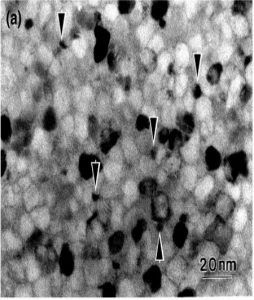
It is well known that the microstructure, noticeably the grain size, essentially determines the hysteresis loop of a ferromagnetic material. Nevertheless, we had to build up a deeper understanding of the coercivity (Hc) in the whole range of structural correlation lengths starting from atomic distances in amorphous alloys over grain sizes (D) in the nanometer regime up to macroscopic grain sizes. The 1/D-dependence of coercivity for large grain sizes reflects the conventional rule that good soft magnetic properties require very large grains (D>100μm). Thus, the reduction of particle size to the regime of the domain wall width increases the coercivity Hc. On the other hand lowest coercivities are again found for smallest structural correlation lengths like in amorphous alloys and in nanocrystalline alloys for grain sizes D<20nm. The new nanocrystalline material fills in the gap between amorphous metals and conventional poly-crystalline alloys. The combination of small grain size and soft magnetic properties is surprising and fascinating from the classical point of view in magnetic engineering.
Role of Nanocrystalline Soft Magnetic Materials in electronic devices and other applications.
The strip shaped soft magnetic amorphous and nanocrystalline material is used to produce so-called tape wound cores (=magnetic cores). Adding copper windings lead to well-known inductive components for electronic industry.
VACCUMSCHMELZE is the market and technology leader in many applications with years of experience in the international market. The company’s expertise covers the entire development process from knowledge of the characteristics of the alloy to fabrication technology and low cost manufacturing sites.
VAC produces inductive components based on nanocrystalline material for the installation, the automotive and the industrial market.
Examples for the installation market: Total current converters for earth fault current protection switches and current converters for electronic energy meters.
Examples for the automotive market: Chokes and transformers for the power management, flexible antennas for Keyless-Entry-Systems, for hybrid and electric vehicles: Recuperation-Systems, Start-Stop-Systems and DC/DC converters.
Examples for the industrial market: Chokes, transformers and power sensors for power supplies and rectifiers. Common mode chokes and nanocrystalline cores pave the way for compact innovative filter designs with highest efficiency for superior electrical motor drives according to newest international regulations. Gate drive transformers provide highest safety, excellent reliability and long lifetime for specialty (high voltage) applications combining efficiently energy- and signal- transmission in one component resulting in lower total costs. Current sensors offer maximum accuracy.
Newer Developments: High Frequency Applications (size reduction).

Vacuumschmelze is traditionally a supplier for inductive components. Conventional inductive components, like magnetic cores, inductive components, chokes and transformers, as well as flexible antennas are big and placed on top of PCB’s. All these established products are generally used in the lower frequency range, e.g. at 50Hz or up to some kHz.
Responding to future challenges for electronic circuits we have been faced with new requirements – especially there was a trend to use higher frequencies and consequently the trend for miniaturisation. This enables the use of embedded components where caps, semiconductors, resistors and inductances find a place inside of the PCB, respectively on one layer of a multilayer PCB.
To do first steps in this direction we take part in a joint research project called VISA, which was founded by the German Federal Ministry of Education and Research. Where we had to improve our amorphous or nanocrystalline soft magnetic materials in order to make them ready for high frequencies and embedding. Such inductive components should be flat, the maximum height should not exceed 1mm, the iron losses should be as low as possible and a high quality factor at switching frequency up to the MHz range was requested. For application, we were focused to DC/DC converters for the small power range. In addition, we expected applications for cores, planar inductors, shielding materials and sensors for automotive industry e.g. e-drive systems, for power LED technology or photovoltaic chargers or for shielding applications, like wireless charging systems.
Newer Developments: High Saturation Materials (size reduction).
Nanocrystalline Fe-Cu-Nb-Si-B alloys are well known to exhibit excellent soft magnetic properties (low coercivity flield Hc and high permeability µ) combined with low magnetostriction (ls) and high saturation polarization around Js ~ 1.2T. They are meanwhile widely used in magnetic applications.
Since their discovery, a major driving force for further alloy development has been to increase the saturation polarization in order to receive a higher effective flux change after reversing the magnetic excitation. Thus, a higher inductance level could be achieved at simultaneously smaller volume. The most recent development are Fe-Si-B-P-Cu alloys which are reported to show high saturation polarization around Js ~ 1.8 T as well as reasonably low coercivity (Hc<10 A m).
One problem associated with these new alloys is that they are located near the glass-forming boundary, leading to serious production issues. Newer compositions investigated in the last years have been recently shown to exhibit sufficient glass forming ability for large-scale production. However, the saturation magnetostriction of nanocrystalline Fe-Si-B-P-Cu alloys is still relatively high (ls≈14 ppm). Low magnetostriction, however, is important for good soft magnetic properties and stress insensitivity of the hysteresis loop. The objective of current development is to investigate application capability of such alloy systems and to provide the so far missing behavior of magnetic properties, particularly in the nanocrystalline state.

